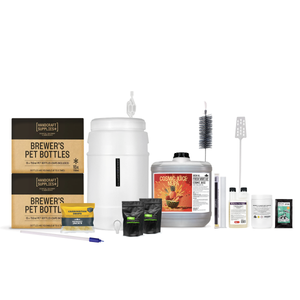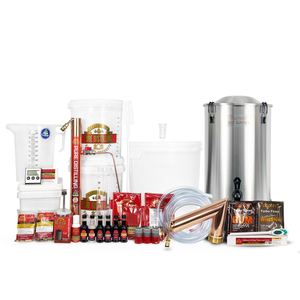
Oktoberfest Marzen 20L Fresh Wort Kit - Seasonal Release
Fresh Wort Kit
An amber lager celebrating Oktoberfest highlighting rich malt flavours and a crisp, crushable finish!
This medium-bodied amber lager is smooth and approachable, making it an ideal choice for celebrating Oktoberfest or enjoying during crisp autumn evenings. Perfect for both novice and seasoned brewers, simply pour, ferment, and enjoy.
This is our first seasonal release fresh wort kit. This kit will be released annually; during September when Oktoberfest takes place in Germany. This is part of our limited release series and will not be available year round.
It pours a rich amber with a creamy, off-white head. The aroma highlights notes of toasted malt, caramel, and a hint of nuttiness. Taste wise, you’ll experience a smooth, malt-forward profile balanced by a gentle touch of hops, providing a refined bitterness and a clean, traditional lager finish.
Tips for best results:
When it comes to this beer style it's all in the yeast and fermentation. We would highly recommend using a traditional lager yeast and brewing it cooler to minimise the production of unwanted esters (yeast flavours). Using a strain such as Saflager W-34/70, Mangrove Jack's M76 or Bluestone Pilsen will help to accentuate the malt flavours that drive this beer. When brewing beers at cooler temperatures it's important to ensure you have a high enough cell count for a healthy fermentation, minimising flavours and getting a good attenuation. We'd highly recommend making a yeast starter to build up your yeast culture for best results; alternatively you can use 2-3 packs of dry yeast to get the same result. Make sure to follow the manufacturers recommendation for fermentation temperature as these can vary between styles. If you have no way to control fermentation temperature we would recommend using a Pseudo-lager yeast such as Omega Yeast Lutra or Lalbrew Novalager.
Yeast and dry hops sold separately*
Specifications:
Grains: Munich (40%), Pilsner (20%), Vienna (20%), Dark Munich (17%), Caramunich 2 (2.5%)
Hops: Warrior, Saaz
IBU: 19
Colour: 18 EBC
Mash Temp: Sacc Rest - 67°C, Mash Out 75°C
Makes: 20 litres
Approximate Original Gravity: 1.050
Approximate Final Gravity: 1.011
Approximate ABV: 5.4%
Recommended Yeast:
Fermentis Saflager W-34/70 - Ideal temperature 12°C - 18°C (can also be fermented slightly warmer with minimal flavour deviation, try not to exceed 22°C)
Bluestone Pilsen - Ideal Temperature 10°C - 16°C (ensure to pitch than a higher recommended cell count as to not underattenuate)
Mangrove Jacks M76 Bavarian Lager - Ideal temperature 8°C - 14°C
Omega Yeast Lutra - Ideal Temperature 20°C - 40°C
Lalbrew Novalager - Ideal Temperature 10°C - 20°C
Recommended Dry Hops:
No dry hops recommended for this fresh wort kit.
Instructions:
1. Sanitise your fermenter and brewing equipment.
2. Ensure the temperature of the fresh wort is within range of your selected yeast strains ideal fermentation temperature.
3. Pour the contents of the fresh wort kit into your sanitised fermenter. Pour the fresh wort hard into your fermenter. Splashing of the wort allows the wort to dissolve oxygen which ensures a healthy fermentation.
4. Pitch the yeast into the wort.
5. Add the recommended dry hops (if applicable), as fermentation is nearly finished.
6. Ferment your beer until the gravity is stable.
7. Bottle or keg your beer.
8. Enjoy!


